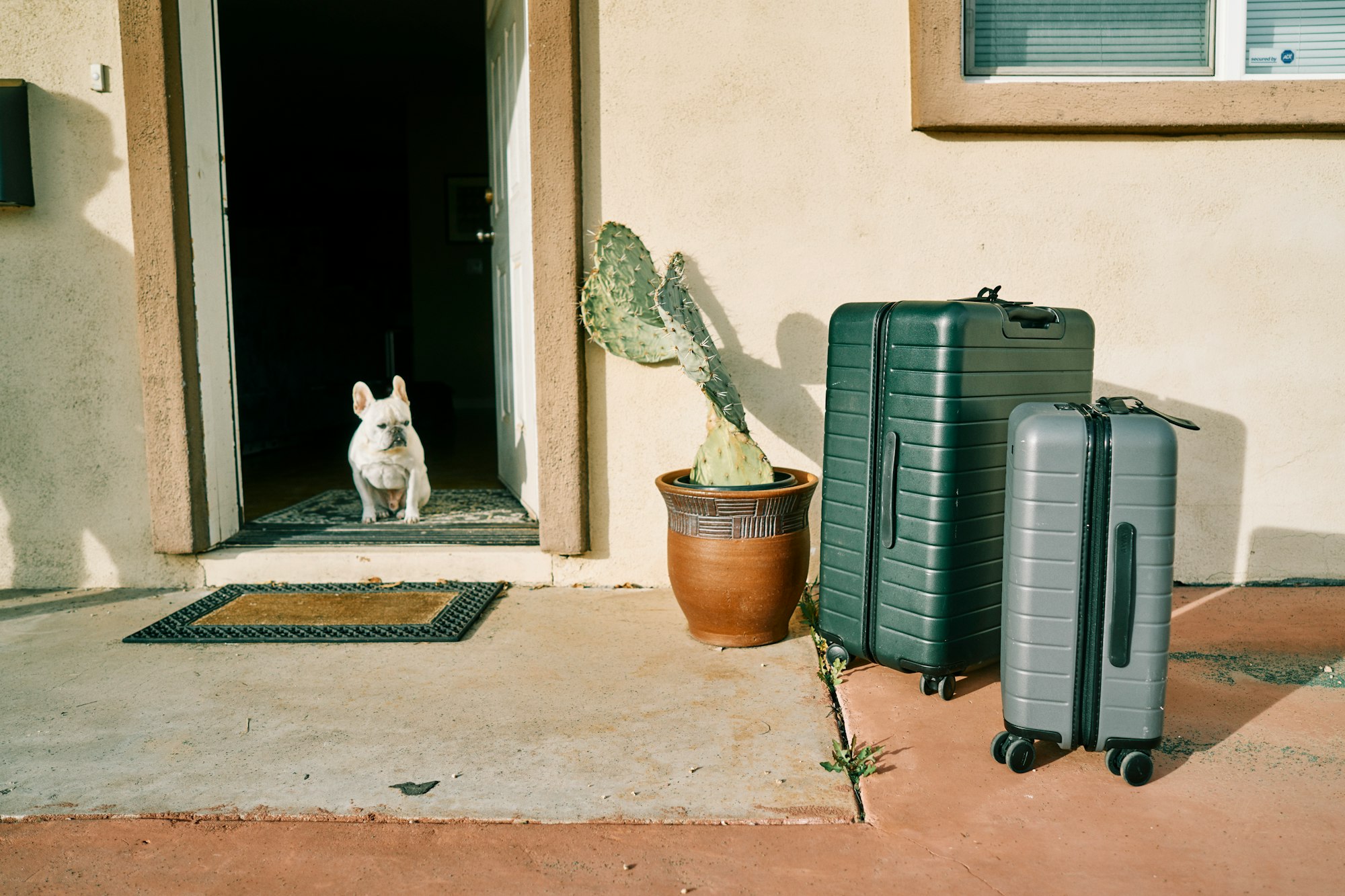Let's be honest, traveling with your dog or house pet as a digital nomad is an awesome adventure. But it could also be challenging sometimes.
This is because our furry friends might often feel a little stressed and confused when changing their home and territory.
Moreover, some restrictions might limit your personal life too. For instance, we sadly know that many restaurants don't accept dogs in restaurants or grocery stores.
The great news is that there's always a solution around the corner. And that's why we are here: to help you find it.
In this article, we will walk you through anything you need to know about traveling internationally with your dog (or any other house pet) as a digital nomad, so you can be better prepared and have stress-free travels!

Traveling with a House Pet Is Possible
If you are a Digital Nomad and have planned to bring with you your dog, cat, or any other house pet, you should be looking for the safest and most comfortable way to travel for them.
Before you buy a ticket for your destination, there is some information that you should know in advance, including whether the country is pet friendly enough or if the accommodation you like welcomes dogs or other pets.
Most countries around the world only accept animals if they are emotional-support animals. There may be separate policies for pets other than cats and dogs, so be sure to do your own research if you’re planning to bring along animals like reptiles or rodents.
If you can't manage to plan a trip by yourself, know that there are also specialized pet agencies that can help you move internationally with your pet, so this might be an option to consider.
But the most important decision when traveling internationally with your dog or cat is which kind of transportation you will use.
Ideally, driving by car would always be the best option.

Sadly, when traveling internationally, it's often likely that you won't be able to use a car for your trip.
Let's see then which options you have and what might be the requirements for each mode of transportation.
Traveling With Pets Using Public Transportation
If you travel by public transportation, make sure to know the rules of the country you are traveling to.
Not all countries allow you to bring on board a dog or a pet because of culture and laws. Some require pet health and immunization while others require you to use carriers when transporting dogs.
Most countries also demand to microchip your dog and parasite treatment forms and rabies tests can also be asked before the departure or arrival.
Some places like Australia may instead demand that your friend goes into a 10-day quarantine. This is because these countries are often free from pet diseases so they are interested in protecting this highly favorable animal health status.

Traveling With Pets By Airplane
When booking a flight for yourself and your four-legged friend, you must consider all the options but also all the risks you might incur.
We have collected some tips that might help you before deciding to transport your dog or house pet by airplane:
1) Not all airlines are equal. Some of them are happy to welcome your dog, but others might refuse to allow animals on board. If moving with your dog by airplane is your only option, choose the airline that allows your pets to travel in the cabin with you.
It might be helpful for you to know that the ones below are the most pet-friendly airlines in the world:
- KLM Royal Dutch Airlines
- Qantas Airways
- Air Canada
- Singapore Airlines
- Virgin Atlantic Airways
- Air France
- American Airlines
2) A limited number of animals are allowed to stay in the cabin. Plan in advance your trip to avoid any surprises;
3) There might be additional costs that you might incur. This will differ from one airline to another. Make sure to pay extra attention to fees, especially if your dog must stay in a cargo hold.
4) Direct flights are always better than layovers. However, if you must change plane(s), always ask for information about the pet transfer to the other plane and inform the captain of your dog in the cargo. The captain must know that there is an animal hold in the cargo.
5) Put a travel label on the carrier and the collar. The label will need to contain your ID, phone numbers, and addresses. This will help you get contacted if your pet gets lost.
6) Take a picture of your pet with you. If they are lost, a photo will help to search for them.
7) Examine your pet upon arrival. You must report the issue to the airline company if you note something wrong. It would be better if a veterinarian could write the examination, including the execution date.

Traveling With Pets By Ship
Pets are welcomed on only a few cruise lines when traveling by ship. It is possible to travel in private cabins, but, unfortunately, most travel companies confine dogs to kennels.
There are different types of ships you might be using when traveling with pets as a digital nomad. They include ferries, cruise ships, dedicated pet ships, and yachts.
Each destination has its own rules when transporting pets from another country or continent.
Consider also that, like humans, animals are commonly afflicted by seasickness. In particular, studies show that puppies seem to suffer the most.
Moreover, pets can also feel stressed when on a ship, so consider it carefully when wanting to choose it as your favorite mode of transportation.

Traveling With Pets By Train Or Buses
Traveling by train is much easier than other transportation. Many trains in Western countries allow, in fact, dogs and other pets.
The pet owner has the responsibility for their pets, and, in some cases, they must also buy a ticket for their little friend.
Generally, dogs are not allowed in restaurant cars, except for guide dogs.
Dogs must always be kept on a lead unless they have a carrier. Dogs without leads, along with cats, birds, and small animals, must be carried in an enclosed basket to prevent escape.
Finally, pet owners must always keep their pets under their control when on buses or trains.

Be Careful: Countries Have Different Cultures
It’s hard to find comprehensive information on the legality of animal cruelty throughout the world.
Treating animal welfare is a delicate topic with many different arguments and points of view from country to country.
For anyone looking to move to another country with their fidos, here are some of the best and worst countries for pets:
Most Pet-Friendly Countries:
Austria, Switzerland, Germany, Hungary, France, United Kingdom, Bosnia & Herzegovina, Croatia, Estonia, Italy, Latvia, Malta, Montenegro, Netherlands, Portugal, and Spain.
Least Pet-Friendly Countries:
Japan, China, Egypt, Greece, Saudi Arabia, India, Australia, Argentina, Iran, Belarus, Russia, Brazil, Morocco, and Chile.

How To Look For Accommodation With A Pet
Finding affordable accommodation that suits your needs can be one of the biggest struggles as a digital nomad.
But if you have a dog or other house pets, things could get even more complicated, although not impossible.
There are, in fact, many websites where to browse for pet-friendly accommodation.
Here is a comprehensive list of the most famous sites where you can request and ask whether your little friend is welcome:
- Facebook Marketplace
- Facebook Groups
- Airbnb
- Trusted House-sitters
- Anyplace
- Spot a Home
- Nomad Stays
- Hostel World
When you’re looking for a pet-friendly or pet-free house, make sure to check the pet policy in the House Rules section of each accommodation. This is where house owners will mention if they allow hosting a pet, above all if they are Service Animals.

What Is The Pet Travel Scheme (PETS)?
You should know that some EU countries require PETS.
PETS is a system that allows animals to travel between EU member countries without a quarantine period. The animal has a passport containing official records and information that simplifies traveling with pets.
With an EU Pet Passport, dogs, cats, and ferrets can travel freely within the EU and some non-EU countries. Below you can find the full list:
List of EU countries:
Austria, Azores, Balearic Islands, Belgium, Bulgaria, Canary Islands, Ceuta, Cyprus, Czech Republic, Denmark, Estonia, Faroe Island, Finland, France, French Guiana, Germany, Gibraltar, Greece, Greenland, Guadeloupe, Hungary, Ireland, Italy, Latvia, Lithuania, Luxemburg, Madeira, Malta, Martinique, Melilla, Netherlands, Poland, Portugal, reunion, Romania, Slovakia, Slovenia, Spain, Sweden,
List of Non-EU Countries:
Andorra, Antigua and Barbuda, Argentina, Aruba, Ascension Island, Australia, Bahrain, Barbados, Belarus, Bermuda, Bes Islands, Bosnia Herzegovina, British Virgin Islands, Canada, Cayman Islands, Chile, Croatia, Curacao, Falkland Islands, Fiji, French Polynesia, Guam, Hawaii, Hong Kong, Iceland, Jamaica, Japan, Liechtenstein, Malaysia, Mauritius, Mayotte, Mexico, Monaco, Monserrat, New Caledonia, New Zealand, Norway, Russian Federation, Saint Maarten, San Marino, Singapore, St. Helena, St Kitts and Nevis, St Lucia, St Pierre and Miquelon, St Vincent and the Grenadines, Switzerland, Taiwan, Trinidad and Tobago, United Arab Emirates, USA, Vanuatu, Vatican, Wallis, and Futuna.

Are You Ready To Travel Around the World With Your Pet?
If you want to receive digital nomad guides like these, sign up for our newsletter and get upcoming articles straight to your inbox!
You can also follow us on Instagram and join our Facebook Group if you want to get in touch with other members of our growing digital nomad community!
We'll see you there, Freaking Nomads!
Disclosure: Hey, just a heads up that some of the links in this article are affiliate links. This means that, if you buy through our links, we may earn a small commission that helps us create helpful content for the community. We only recommend products if we think they will add value, so thanks for supporting us!





